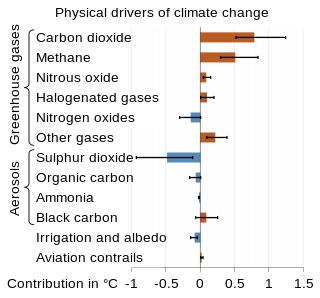Related Research Articles

The scientific community has been investigating the causes of climate change for decades. After thousands of studies, it came to a consensus, where it is "unequivocal that human influence has warmed the atmosphere, ocean and land since pre-industrial times." This consensus is supported by around 200 scientific organizations worldwide, The dominant role in this climate change has been played by the direct emissions of carbon dioxide from the burning of fossil fuels. Indirect CO2 emissions from land use change, and the emissions of methane, nitrous oxide and other greenhouse gases play major supporting roles.

Numerical climate models are mathematical models that can simulate the interactions of important drivers of climate. These drivers are the atmosphere, oceans, land surface and ice. Scientists use climate models to study the dynamics of the climate system and to make projections of future climate and of climate change. Climate models can also be qualitative models and contain narratives, largely descriptive, of possible futures.

A general circulation model (GCM) is a type of climate model. It employs a mathematical model of the general circulation of a planetary atmosphere or ocean. It uses the Navier–Stokes equations on a rotating sphere with thermodynamic terms for various energy sources. These equations are the basis for computer programs used to simulate the Earth's atmosphere or oceans. Atmospheric and oceanic GCMs are key components along with sea ice and land-surface components.
The Carl-Gustaf Rossby Research Medal is the highest award for atmospheric science of the American Meteorological Society. It is presented to individual scientists, who receive a medal. Named in honor of meteorology and oceanography pioneer Carl-Gustaf Rossby, who was also its second (1953) recipient.

Radiative forcing is a concept used in climate science to quantify the change in energy balance in Earth's atmosphere. Various factors contribute to this change in energy balance, such as concentrations of greenhouse gases and aerosols, and changes in surface albedo and solar irradiance. In more technical terms, it is defined as "the change in the net, downward minus upward, radiative flux due to a change in an external driver of climate change." These external drivers are distinguished from feedbacks and variability that are internal to the climate system, and that further influence the direction and magnitude of imbalance. Radiative forcing on Earth is meaningfully evaluated at the tropopause and at the top of the stratosphere. It is quantified in units of watts per square meter, and often summarized as an average over the total surface area of the globe.
The Community Climate System Model (CCSM) is a coupled general circulation model (GCM) developed by the University Corporation for Atmospheric Research (UCAR) with funding from the National Science Foundation (NSF), the Department of Energy (DoE), and the National Aeronautics and Space Administration (NASA). The coupled components include an atmospheric model, a land-surface model, an ocean model, and a sea ice model. CCSM is maintained by the National Center for Atmospheric Research (NCAR).

The emissivity of the surface of a material is its effectiveness in emitting energy as thermal radiation. Thermal radiation is electromagnetic radiation that most commonly includes both visible radiation (light) and infrared radiation, which is not visible to human eyes. A portion of the thermal radiation from very hot objects is easily visible to the eye.

Numerical weather prediction (NWP) uses mathematical models of the atmosphere and oceans to predict the weather based on current weather conditions. Though first attempted in the 1920s, it was not until the advent of computer simulation in the 1950s that numerical weather predictions produced realistic results. A number of global and regional forecast models are run in different countries worldwide, using current weather observations relayed from radiosondes, weather satellites and other observing systems as inputs.
In climatology, the Coupled Model Intercomparison Project (CMIP) is a collaborative framework designed to improve knowledge of climate change. It was organized in 1995 by the Working Group on Coupled Modelling (WGCM) of the World Climate Research Programme (WCRP). It is developed in phases to foster the climate model improvements but also to support national and international assessments of climate change. A related project is the Atmospheric Model Intercomparison Project (AMIP) for global coupled ocean-atmosphere general circulation models (GCMs).
Parameterization in a weather or climate model is a method of replacing processes that are too small-scale or complex to be physically represented in the model by a simplified process. This can be contrasted with other processes—e.g., large-scale flow of the atmosphere—that are explicitly resolved within the models. Associated with these parameterizations are various parameters used in the simplified processes. Examples include the descent rate of raindrops, convective clouds, simplifications of the atmospheric radiative transfer on the basis of atmospheric radiative transfer codes, and cloud microphysics. Radiative parameterizations are important to both atmospheric and oceanic modeling alike. Atmospheric emissions from different sources within individual grid boxes also need to be parameterized to determine their impact on air quality.

The Max Planck Institute for Chemistry is a non-university research institute under the auspices of the Max Planck Society in Mainz, Germany. It was created as the Kaiser Wilhelm Institute for Chemistry in 1911 in Berlin.

In atmospheric science, an atmospheric model is a mathematical model constructed around the full set of primitive, dynamical equations which govern atmospheric motions. It can supplement these equations with parameterizations for turbulent diffusion, radiation, moist processes, heat exchange, soil, vegetation, surface water, the kinematic effects of terrain, and convection. Most atmospheric models are numerical, i.e. they discretize equations of motion. They can predict microscale phenomena such as tornadoes and boundary layer eddies, sub-microscale turbulent flow over buildings, as well as synoptic and global flows. The horizontal domain of a model is either global, covering the entire Earth, or regional (limited-area), covering only part of the Earth. The different types of models run are thermotropic, barotropic, hydrostatic, and nonhydrostatic. Some of the model types make assumptions about the atmosphere which lengthens the time steps used and increases computational speed.
Geophysical Fluid Dynamics Laboratory Coupled Model is a coupled atmosphere–ocean general circulation model (AOGCM) developed at the NOAA Geophysical Fluid Dynamics Laboratory in the United States. It is one of the leading climate models used in the Fourth Assessment Report of the IPCC, along with models developed at the Max Planck Institute for Climate Research, the Hadley Centre and the National Center for Atmospheric Research.
A chemical transport model (CTM) is a type of computer numerical model which typically simulates atmospheric chemistry and may give air pollution forecasting.
TOMCAT/SLIMCAT is an off-line chemical transport model (CTM), which models the time-dependent distribution of chemical species in the troposphere and stratosphere. It can be used to study topics such as ozone depletion and tropospheric pollution, and was one of the models used the IPCC report on Aviation and the Global Atmosphere. It incorporates a choice of detailed chemistry schemes for the troposphere or stratosphere, and an optional chemical data assimilation scheme.
The Jule G. Charney Award is the American Meteorological Society's award granted to "individuals in recognition of highly significant research or development achievement in the atmospheric or hydrologic sciences". The prize was originally known as the Second Half Century Award, and first awarded to mark to fiftieth anniversary of the society.
Earth systems models of intermediate complexity (EMICs) form an important class of climate models, primarily used to investigate the earth's systems on long timescales or at reduced computational cost. This is mostly achieved through operation at lower temporal and spatial resolution than more comprehensive general circulation models (GCMs). Due to the nonlinear relationship between spatial resolution and model run-speed, modest reductions in resolution can lead to large improvements in model run-speed. This has historically allowed the inclusion of previously unincorporated earth-systems such as ice sheets and carbon cycle feedbacks. These benefits are conventionally understood to come at the cost of some model accuracy. However, the degree to which higher resolution models improve accuracy rather than simply precision is contested.
Joyce Penner is an atmospheric scientist known for her research on climate change, especially on the impact of aerosols and clouds.

Ulrike Lohmann is a climate researcher and professor for atmospheric physics at the ETH Zurich. She is known for her research on aerosol particles in clouds.
Bjorn Stevens is an American climate scientist who is managing director of the Max Planck Institute for Meteorology in Hamburg. He is known for his research on climate sensitivity, aerosols and especially clouds.
References
- ↑ "MPI: ECHAM Page". Max Planck Institute for Meteorology. Archived from the original on 2011-05-14.
- ↑ Archived 2009-01-31 at the Wayback Machine
- ↑ Roeckner E.; et al. "The atmospheric general circulation model ECHAM 5. PART I: Model description" (PDF). Max Planck Institute for Meteorology. Archived (PDF) from the original on 2006-12-13. Retrieved 2021-08-11.
- ↑ IPCC Data Distribution Centre. "IPCC-DDC: SRES-AR4 GCM data". Archived from the original on 2013-02-16.
- ↑ Max Planck Institute for Meteorology. "Modelle & Daten model abbreviations". Archived from the original on 2011-07-19.
- ↑ Connolley, William M.; Bracegirdle, Thomas J. (29 November 2007). "An Antarctic assessment of IPCC AR4 coupled models". Geophysical Research Letters. 34 (22): L22505. Bibcode:2007GeoRL..3422505C. doi:10.1029/2007GL031648.
- ↑ Stevens, Bjorn; Giorgetta, Marco; Esch, Monika; Mauritsen, Thorsten; Crueger, Traute; Rast, Sebastian; Salzmann, Marc; Schmidt, Hauke; Bader, Jürgen (2013-06-01). "Atmospheric component of the MPI-M Earth System Model: ECHAM6" (PDF). Journal of Advances in Modeling Earth Systems. 5 (2): 146–172. Bibcode:2013JAMES...5..146S. doi: 10.1002/jame.20015 . hdl:11858/00-001M-0000-000F-E7AA-9. ISSN 1942-2466. Archived from the original (PDF) on 2021-10-21. Retrieved 2021-08-11.